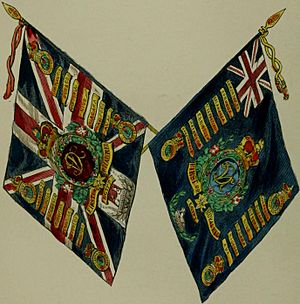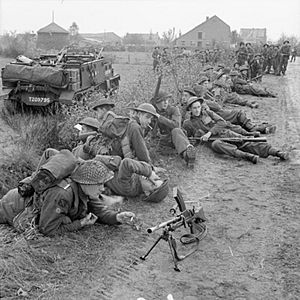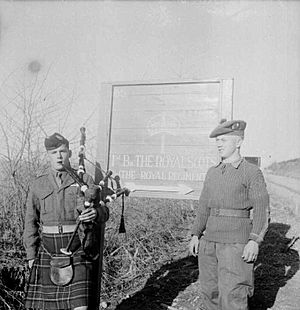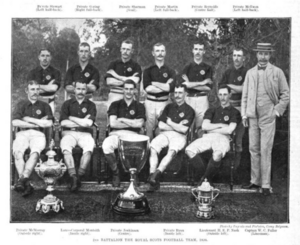Royal Scots facts for kids
Quick facts for kids Royal Scots (The Royal Regiment) |
|
|---|---|

Cap badge
|
|
| Active | 1633–2006 |
| Country | |
| Branch | |
| Type | Infantry |
| Role | Line infantry |
| Part of | Scottish Division |
| Garrison/HQ | Edinburgh |
| Nickname(s) | Pontius Pilate's Bodyguard |
| Patron | HRH Mary, Princess Royal (1918) HRH Anne, Princess Royal (1983) |
| Motto(s) | Nemo me impune lacessit Latin: "Nobody harms me with impunity" |
| March | Quick March: Dumbarton's Drums Slow March: Garb of Old Gaul |
| Engagements | See Battle honours list |
| Insignia | |
| Tactical recognition flash |  |
| Royal Scots regimental badge | 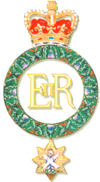 |
The Royal Scots (also known as The Royal Regiment) was a very old and important infantry (foot soldier) group in the British Army. It started way back in 1633 when King Charles I was in charge. The regiment was active for a long time, until 2006. Then, it joined with the King's Own Scottish Borderers to form the Royal Scots Borderers. Later, this new group combined with other famous Scottish regiments like the Black Watch to create the Royal Regiment of Scotland.
Contents
- History of the Royal Scots
- Early Years: 17th Century Adventures
- 18th Century: Wars and Reforms
- French Revolutionary and Napoleonic Wars (1790-1815)
- 19th Century: Global Service and Changes
- First World War (1914–1919)
- Between the World Wars (1919–1939)
- Second World War (1939–1945)
- After the Wars (1945–2004)
- Joining Forces (2004–2006)
- Regimental Museum
- Alliances
- Battle Honours
- Victoria Cross Heroes
- Nicknames
- Football Teams
- Uniforms
- See also
History of the Royal Scots
Early Years: 17th Century Adventures

In April 1633, Sir John Hepburn got permission from King Charles I to hire 1,200 Scottish soldiers. These soldiers were meant to serve with the French army during the Thirty Years War (1618–1648). Many of these soldiers had already fought with the Swedish army. By 1635, the group grew to about 8,000 men.
Sir John Hepburn died in 1636. His brother George took over, and then Lord James Douglas became the leader. The unit became known as the Régiment de Douglas. After James died in 1645, Archibald Douglas, Earl of Angus took command. He mostly helped by sending new soldiers from Scotland. In 1653, George Douglas became the Colonel.
When Charles II became king in 1660, Douglas's regiment was sent to England. They helped stop a small uprising. Then they went back to France. They returned to England for a short time during the Second Anglo-Dutch War (1664-1667). They were based at the Chatham naval base. The writer Samuel Pepys heard their unique "Scotch march" played by drums. In 1667, the regiment was accused of stealing after a Dutch attack. They were sent back to France, and many soldiers left the unit.
During the Third Anglo-Dutch War (1672-1674), Douglas's regiment fought with the French. They served in the Rhineland. In 1675, the unit was renamed Régiment de Dumbarton. By 1678, all Scottish and English units had to leave France. Many soldiers chose to stay in France. Those who returned to England arrived without money or belongings.
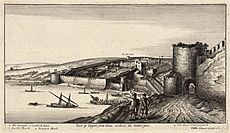
The regiment was then called the First Foot or Royal Scots in England. Four companies joined the Tangier Garrison in 1680. They were given a special honor for 'Tangier' much later, in 1908. The colony was left in 1684. A war diary from 1680, kept by Sir James Halkett, is one of the oldest surviving examples.
In 1684, the unit was renamed His Majesty's Royal Regiment of Foot. In 1685, King James II took over. The regiment fought in the Battle of Sedgemoor, which ended a rebellion. A second group of soldiers was added in 1686 and sent to Scotland.
During the Glorious Revolution in 1688, most of the unit stayed loyal to King James. Their leader, Dumbarton, went into exile. A new leader, Frederick Schomberg, was appointed. In 1689, the soldiers refused to move because they hadn't been paid and didn't like their new foreign commander. But they were treated kindly and later agreed to go.
At the start of the Nine Years War (1688–1697), the first group fought at the Battle of Walcourt in 1689. After Schomberg died, Sir Robert Douglas became the Colonel. The second group joined in 1690. Both groups fought in the Battle of Steenkerque in 1692, where Sir Robert was killed. They also fought at the Battle of Landen in 1693 and the Siege of Namur. After the war ended in 1697, they moved to Ireland.
18th Century: Wars and Reforms
During the War of the Spanish Succession, the regiment served under Marlborough. They fought in major battles like Blenheim, Ramillies, and Oudenarde. At Malplaquet in 1709, one of their soldiers, William Hiseland, was 89 years old! He was thought to be the last veteran of the First English Civil War.
Both groups of soldiers stayed in Ireland from 1715 to 1742. After that, they usually served in different places. The first group was in Flanders during the War of the Austrian Succession. They fought at Fontenoy in 1745. The second group helped stop the Jacobite rising of 1745 after returning from Puerto Bello. Then they went back to Ireland.
In 1751, the unit was officially named the 1st (Royal) Regiment of Foot. It was the most senior infantry regiment. When the Seven Years' War started in 1756, the second group moved to Nova Scotia. They fought at Louisburg, Guadeloupe, and Havana. They returned home in 1764.
Before the American Revolutionary War began in 1775, both groups were stationed in the Mediterranean. The first group was in Gibraltar, and the second in Minorca. In 1781, the first group went to the West Indies. They helped capture St Eustatius. They surrendered at St. Kitts in 1782 but were later exchanged.
French Revolutionary and Napoleonic Wars (1790-1815)
The first group returned to the West Indies in 1790 and stayed until 1797. They fought briefly in the Haitian Revolution. Many soldiers got sick from diseases there. The group was rebuilt with new volunteers in Ireland in 1798. They fought well in the Battle of Vinegar Hill during a rebellion in Ireland.
After the Irish rebellion, they took part in small raids on the Spanish coast in 1800. Meanwhile, the second group was in the Mediterranean from 1793 to 1801. They fought at the Siege of Toulon (1793) and helped capture Corsica (1794). They also fought in the Battle of Egmont op Zee in 1799 and in Egypt in 1801.
Both groups were later sent to the West Indies. The first group was there from 1801 to 1812. They captured Saint Thomas, Saint Lucia, Demerara, Essequibo, and Guadeloupe. The second group was there from 1803 to 1806, then moved to India until 1826. The first group was sent to Quebec when the War of 1812 started. They fought in many battles in Canada and the US, like Chippawa and Lundy's Lane. In 1812, the regiment was officially named the 1st Regiment of Foot (Royal Scots).
Two new groups, the 3rd and 4th Battalions, were formed in 1804. The 3rd Battalion fought in the Peninsular War from 1808 to 1809, including the Battle of Corunna. They returned to Portugal in 1810 and fought in many more battles like Salamanca and Battle of Vitoria. They advanced into France in 1814. This battalion also fought bravely at the Battle of Waterloo in 1815. It was disbanded in 1817.
The 4th Battalion went to the Baltic Sea in 1813 and fought in the Netherlands in 1814. They were captured but later exchanged. Then they were sent to Canada for the War of 1812. They returned to England and were disbanded in 1816.
19th Century: Global Service and Changes
After the Napoleonic Wars, the 1st Battalion was in Ireland from 1816 to 1825, then in the West Indies until 1835. The 2nd Battalion was busier. In India, they fought in the Third Anglo-Maratha War and the First Anglo-Burmese War (1824–26). They moved to Scotland in 1830 and Canada in 1836, where they helped with the Rebellions of 1837. They fought at the Battle of Saint-Denis (1837). In 1843, half the regiment was shipwrecked on their way to the West Indies, but they eventually made it. They returned to Scotland in 1846.
Both battalions fought in the Crimean War. The 1st Battalion fought at Alma and Inkerman (1854). Both fought in the Siege of Sevastopol (1854–55), where the regiment won its first Victoria Cross. After the war, the 1st Battalion went to Ceylon and India, returning home in 1870. The 2nd Battalion went to Hong Kong and fought in the Second Opium War, capturing the Taku Forts (1858) and Pekin (1860). They returned home in 1861.
In 1881, big changes happened in the army. Many regiments were combined. The Royal Scots became The Royal Scots (Lothian Regiment). They took control of various local volunteer groups in areas like Edinburgh and Haddingtonshire. This meant the regiment now had two regular battalions, a militia battalion, and several volunteer battalions.
The 1st Battalion went to South Africa in 1884 and fought in the Bechuanaland campaign. They stayed there until 1891. The 2nd Battalion moved to India in 1891 and stayed until 1909. When the Second Anglo-Boer War started, the 1st Battalion went back to South Africa in 1899. The 3rd Battalion joined them from 1900 to 1902. They mostly patrolled and didn't fight in major battles.
In 1908, the volunteer groups were reorganized. The Royal Scots now had one Reserve battalion and seven Territorial battalions. The 1st Battalion went back to India in 1909, and the 2nd returned to the UK. They stayed in these places until 1914.
First World War (1914–1919)
When the First World War began in 1914, the 1st Battalion was in India but returned to the UK in November. The 2nd Battalion was sent to France immediately, arriving on August 14 and fighting on August 23. Many new battalions were formed, including "Pals battalions" where friends and neighbors could join together. By the end of 1914, the Royal Scots had 24 battalions! More were formed in 1915. In total, the Royal Scots raised about 35 infantry battalions and over 100,000 men during the war. Sadly, 11,000 soldiers were killed, and over 40,000 were wounded. The regiment earned six Victoria Crosses for bravery.
The 1st Battalion arrived in France in December 1914. They fought in the Second Battle of Ypres in 1915. Then they moved to Salonika and stayed there for the rest of the war. They went to Georgia in 1918 and returned to Edinburgh in 1919. The 2nd Battalion was one of the first units sent to France. They fought in the Battle of Mons and almost all major battles on the Western Front. They returned to Scotland in 1919.
The 1/4th and 1/7th battalions went to Edinburgh in August 1914. The 1/7th was involved in the Quintinshill rail crash, a terrible accident that killed many soldiers. They fought at the Battle of Gallipoli, then moved to Egypt in 1916. They were sent to France in April 1918 for the Second Battle of the Somme. Both battalions were disbanded in May 1919.
The 1/5th Battalion also mobilized in Edinburgh in August 1914. They fought at the Battle of Gallipoli and then in France, including the first day on the Somme. The 1/6th Battalion went to Egypt in 1915 and then to France for the Somme. The two groups combined in July 1916 because they had lost so many soldiers. They stayed on the Western Front and were disbanded after the war.
The 1/8th Battalion arrived in France in November 1914, the first Scottish territorial unit there. They fought at the Battle of Neuve Chapelle. The 1/9th Battalion moved to France in February 1915. They fought with different divisions for two years.
The 11th, 12th, and 13th Battalions were formed in Edinburgh in August 1914. They moved to France in mid-1915. They first fought at the Battle of Loos, where the 11th was almost destroyed. They spent the rest of the war on the Western Front. Most were disbanded by the end of 1919.
The 15th, 16th (known as McCrae's Battalion), and 17th Battalions were formed in Edinburgh in 1914-1915. They moved to France in early 1916 and first fought on the first day on the Somme. They stayed on the Western Front for the rest of the war. Most were disbanded by August 1918.
The 2/10th Battalion was the only second-line battalion sent overseas. They went to Archangel in Russia in August 1918 and served in the North Russia Campaign until June 1919. The other battalions stayed in the UK for home defense. Six of them served in Ireland, helping with local security.
Between the World Wars (1919–1939)
After the First World War, the regiment became much smaller. Many battalions were disbanded by 1920. In September 1919, the 1st Battalion went to Rangoon for garrison duties. In August 1920, the 2nd Battalion was sent to Ireland for the Anglo-Irish War, staying until 1922.
In 1920, the Territorial Force became the Territorial Army. All seven Territorial battalions of the regiment were reformed. In 1921, the regiment was officially renamed The Royal Scots (The Royal Regiment). It had two regular battalions, one reserve battalion, and four Territorial Army battalions. Due to army cuts in 1922, the Territorial part was combined into two battalions.
The 1st Battalion moved from Rangoon to Secunderabad in 1922, then to Aden in 1925. They returned to the UK in 1926 and helped during the General Strike. The 2nd Battalion moved to Egypt in 1926, then to China in 1928, and later to India and Hong Kong. The 1st Battalion was sent to Palestine for a year until 1939.
In the late 1930s, the Territorial part of the regiment changed again. One battalion became an anti-aircraft unit in 1938. Another new 8th Battalion was formed in 1939.
Second World War (1939–1945)
When the Second World War started on September 3, 1939, the 1st Battalion was in England. They went to France with the British Expeditionary Force (BEF). In May 1940, they moved into Belgium during the Battle of France. The BEF was pushed back by the German army. The battalion helped protect the escape route for the Dunkirk evacuation. After heavy fighting, the battalion stopped fighting on May 27. Some Royal Scots soldiers were taken prisoner and sadly killed. The remaining soldiers reformed in England. They spent two years preparing for a possible German invasion. In April 1942, the 1st Royal Scots went to British India to train for jungle warfare.
The two Territorial Army units, the 7th/9th and 8th Battalions, mobilized in Scotland in September 1939. The 7th/9th briefly went to France but was quickly pulled back. The regiment formed a fifth battalion in June 1940, which became the 12th Battalion. Two "Home Defence" battalions (10th and 11th) were also formed for defense in the UK. These were usually older or less fit men. The 11th was disbanded in 1940, and the 10th was disbanded in 1943.
In 1941, the 2nd Battalion was in Hong Kong. On December 8, the Battle of Hong Kong began. After fierce fighting, the garrison surrendered on Christmas Day. The newly formed 12th Battalion was reformed as the 2nd Battalion in May 1942.
In April 1942, the 1st Battalion moved to India, then to Chittagong in December. They fought in the Burma Campaign. They saw action in the Arakan operations in 1943. They also fought in the Battle of Kohima in 1944 and the Battle of Mandalay in 1945. They were sent to Singapore in December 1945.
The new 2nd Battalion went to Gibraltar in April 1943. In July 1944, they moved to Italy and fought in the Italian Campaign, including the Anzio Campaign and on the Gothic Line. In January 1945, they moved to Palestine for security duties.
The 7th/9th Battalion was trained for mountain and airlanding operations. In October 1944, they moved to the Netherlands. They fought in the Battle of the Scheldt and then advanced to the Rhine. They crossed the Rhine in March 1945 and reached Bremen by the end of the war.
The 8th Battalion was formed in August 1939. They landed in Normandy in June 1944 as part of Operation Overlord. They fought in the Battle for Caen and later in the North West Europe Campaign. They entered Belgium in September, crossed the Rhine in March 1945, and reached Hamburg by the end of the war.
After the Wars (1945–2004)
In February 1949, the 2nd Battalion was disbanded. This left the regiment with only one regular battalion for the first time in centuries.
The 7th/9th and 8th Battalions were reformed in the Territorial Army in 1947. They remained until 1961, when they combined into the 8th/9th Battalion. In 1967, this was disbanded and reformed as two separate companies. By 1971, the Royal Scots no longer had a Territorial Army element under its direct name.
The 1st Battalion briefly served in the Korean War in 1953. After a short time in Egypt, they went to Cyprus from 1955 to 1956. They then spent time in England, Berlin, Scotland, Libya, and back in England. In 1964, they went to Aden, then back to England, and then to Germany.

From 1970 to 1974, they were in Britain and had two tours of duty in Northern Ireland. In 1974, they were in Cyprus when Turkey invaded. They helped move families and tourists to safety. A piper, Malcolm Halliday, became known as "The piper of Cyprus" for playing at the roadside during this time. They returned to Scotland and had another tour in Northern Ireland, where three soldiers were lost in a bomb attack. In 1976, they moved to Münster in Germany. They returned to Scotland in 1979. In 1980, they had a two-month tour in Northern Ireland, then a two-year deployment there from 1981. In 1983, they went to the Falkland Islands for four months. In 1985, they returned to Germany and then deployed to the Persian Gulf in 1990 for Operation Desert Storm.
In 1994, the battalion gained a company of Gurkhas. In the 1990s, they had another year-long tour in Northern Ireland. They were deployed to Bosnia in 2002 and then to Iraq in November 2003 for six months. They returned to Iraq again in January 2006.
Joining Forces (2004–2006)
Until 2004, the Royal Scots was one of only five infantry regiments that had never combined with another. However, on March 28, 2006, five Scottish regiments joined to form the Royal Regiment of Scotland. The Royal Scots Battalion and the King's Own Scottish Borderers Battalion initially kept their separate names.
But soon after, the Ministry of Defence decided to combine them. This idea had been discussed before. The Royal Scots Battalion and King's Own Scottish Borderers Battalion officially joined on August 1, 2006. The new battalion was named the Royal Scots Borderers, 1st Battalion Royal Regiment of Scotland.
The remaining Territorial part of the Royal Scots also combined, becoming a company within the 6th Battalion, The Royal Regiment of Scotland.
Regimental Museum
The Museum of the Royal Scots (The Royal Regiment) and the Royal Regiment of Scotland is located in Edinburgh Castle. It's an independent museum with displays of uniforms, medals, weapons, drums, and other items. It shows the regiment's history from 1633 to modern army life.
Alliances
The Royal Scots had alliances with other military units:
 The Canadian Scottish Regiment (Princess Mary's)
The Canadian Scottish Regiment (Princess Mary's) Royal Newfoundland Regiment
Royal Newfoundland Regiment
Battle Honours
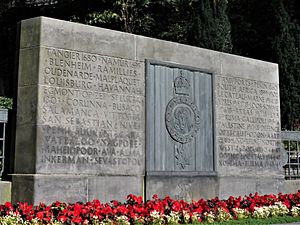
Battle honours are special awards given to military units for their bravery in battles. The Royal Scots earned many battle honours, including:
- Tangier 1680, Namur 1695, Blenheim, Ramillies, Oudenarde, Malplaquet, Louisburg, Havannah, Egmont-op-Zee, Egypt, St Lucia 1803, Corunna, Busaco, Salamanca, Vittoria, San Sebastian, Nive, Peninsula, Niagara, Waterloo, Nagpore, Maheidpoor, Ava, Alma, Inkerman, Sevastopol, Taku Forts, Pekin 1860, South Africa 1899–1902
- World War I: Mons, Le Cateau, Retreat from Mons, Marne 1914 '18, Aisne 1914, La Bassée 1914, Neuve Chapelle, Ypres 1915 '17 '18, Gallipoli 1915–16, Rumani, Egypt 1915–16, Gaza, Palestine 1917–18, Archangel 1918-19, and many more.
- World War II: Dyle, Defence of Escaut, St Omer-La Bassée, Odon, Cheux, Defence of Rauray, Caen, Esquay, Mont Pincon, Scheldt, Flushing, Roer, Rhineland, Reichswald, Cleve, Goch, Rhine, Uelzen, Bremen, Artlenberg, North-West Europe 1940, '44–45, Gothic Line, Marradi, Monte Gamberaldi, Italy 1944–45, South East Asia 1941, Donbaik, Kohima, Relief of Kohima, Aradura, Shwebo, Mandalay, Burma 1943–45
- Wadi Al Batin, Gulf 1991
Victoria Cross Heroes
The Victoria Cross (VC) is the highest award for bravery in the British military. These brave soldiers from the Royal Scots earned the Victoria Cross:
- Private Robert Dunsire, First World War (1915)
- Captain Roland Edward Elcock, First World War (1918)
- Lieutenant David Stuart McGregor, First World War (1918)
- Private Hugh McIver, First World War (1918)
- Private Joseph Prosser, Crimean War (1855)
- Captain Henry Reynolds, First World War (1917)
- Private Henry Howey Robson, First World War (1914)
Nicknames
The Royal Scots were known by the nickname Pontius Pilate's Bodyguard. This name supposedly came from a friendly argument with a French regiment in the 1600s. The French regiment, Picardie, was very old. The Scots claimed their history went back even further, to soldiers serving under Pontius Pilate during the time of Christ! The French joked, "Oh, so you're Pontius Pilate's Bodyguard?" The Scots supposedly replied that if their regiment had been guarding the tomb, it wouldn't have been empty the next morning.
The 2nd Battalion was also sometimes called The First to Foot It during the Battle of Hong Kong.
Football Teams
The football team of the 1st Battalion played in the Irish Football League for the 1899–1900 season. This was when they were stationed in Belfast.
The 2nd Battalion team won several competitions in the 1890s, including the Surrey Cup and the Malta Cup.
Uniforms
Early uniforms were red coats with white details. Later, in the 1700s, they changed to "royal blue" details. The Scottish thistle was often on their uniform parts. By 1881, they adopted a "Lowland" Scottish style. This included a red jacket called a doublet, tartan trousers called trews, and a dark blue hat called a Kilmarnock bonnet with a checkered band and a feather. This was their formal uniform until 1939. In later years, their everyday uniform included a dark blue bonnet, a dark blue doublet, and Hunting Stewart tartan trews.
See also





